05 Jan ICH Q5 A (R1) Revision: Viral safety evaluation of biotechnology products derived from cell lines of human or animal origin
The ICH Q5A(R2) Expert Working Group is working on the revision of the of the Guideline Q5A(R1) “Quality of Biotechnological Products: Viral Safety Evaluation of Biotechnology Products Derived from Cell Lines of Human or Animal Origin”, providing additional recommendations on the established and complementary approaches to control the potential viral contamination of biotechnology products:
- selecting and testing cell lines and other raw materials;
- assessing the capacity of the production process to clear infectious viruses;
- testing the product at appropriate steps of production.
The draft guideline text is currently at step 2 of the ICH process and was endorsed on 29 September 2022.
On 10 October 2022, EMA published a revised version, which is open for comments until 10 February 2023.
Scope
The previous guidance refers to products derived from cell cultures obtained from characterised cell banks. It covers products derived from in vitro cell cultures, such as interferons, monoclonal antibodies and recombinant DNA products, including recombinant subunit vaccines. It also includes products derived from hybridoma cells grown in vivo as ascites, for which special considerations apply.
In the new guidance, the following statement can be found in comparison:
“This document covers products produced from in vitro cell culture using recombinant DNA technologies such as interferons, monoclonal antibodies, and recombinant subunit vaccines. It also covers products derived from hybridoma cells grown in vivo as ascites: special considerations apply for these products, and Annex 1 contains additional information on testing cells propagated in vivo. The document also applies to certain genetically-engineered viral vectors and viral vector-derived products, which can undergo virus clearance without a negative impact on the product. These products may include viral vectors produced using transient transfection or from a stable cell line, or by infection using a recombinant virus. It also includes viral vector-derived recombinant proteins, for example, baculovirus-expressed Virus-Like Particles (VLPs), protein subunits and nanoparticle-based vaccines and therapeutics. Furthermore, the scope includes Adeno-Associated Virus (AAV) gene therapy vectors that depend on helper viruses such as baculovirus, herpes simplex virus or adenovirus for their production. Specific guidance on genetically engineered viral vectors and viral vector-derived products is provided in Annex 7. Inactivated viral vaccines and live attenuated viral vaccines containing self-replicating agents are excluded from the scope of this document.”
Next Generation Sequencing (NGS) and Nucleic Acid Amplification Techniques (NATs) may be appropriate for broad and specific virus detection, respectively. The introduction of these tests may be done without a systematic head-to-head comparison with the currently recommended in vitro and in vivo assays.
Objective
All biotechnological products derived from cell lines are at risk of viral contamination, which could have serious side effects or clinical consequences for the patient. This can be due to viral contamination of the starting material or contamination during the manufacturing process.
It is assumed that the safety of these products with respect to potential viral contamination can be ensured by applying a virus analysis programme and evaluating the virus removal and inactivation achieved by the manufacturing process through the appropriate measures described in this guidance document.
Summarized is the purpose of this document to provide a general framework for viral testing, experiments for the assessment of viral clearance and a recommended approach for the design of viral testing and viral clearance studies.
The guideline mentions three different, complementary approaches to controlling the potential viral contamination of biotechnology products:
- Selecting and testing cell lines and other raw materials, including media components, for the absence of undesirable infectious viruses;
- Assessing the capacity of the production processes to clear infectious viruses;
- Testing the product at appropriate steps of production for the absence of contaminating infectious viruses.












